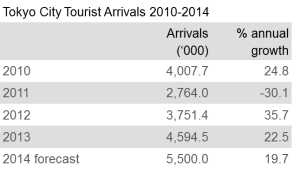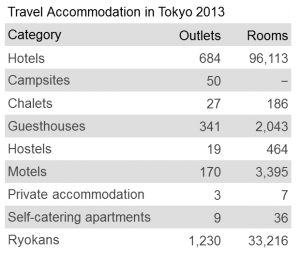![]()
Key Findings
Strong recovery in demand from international markets: After a sharp drop in arrivals in 2011, inbound tourism recovered surprisingly quickly and Tokyo has since enjoyed strong double-digit annual growth, driven by the weaker yen and increased flight capacity.
Growth of Southeast Asian markets: Boosted by the easing of visa restrictions, Southeast Asian countries will become increasingly important to inbound travel in Japan. Arrivals from Thailand are expected to increase by 113% between 2013 and 2018, followed by Malaysia and Indonesia, with 133% and 105% respectively.
Domestic tourism bounces back strongly: Domestic tourism has performed even better than international markets since 2011, benefiting from a change in mindset among Japanese – notably a desire for increased leisure time, including travel.
Leisure gains on business: The growth in leisure travel demand has been much stronger than for business trips, which declined to less than 40% of total trips, down from 57% in 2009.
Olympics spur public and private sector investment: Foreign investment interest in developing hotels and other tourism attractions appears to have soared since Tokyo won its bid to host the 2020 Olympics.
Tokyo loses favour as a MICE destination: Tokyo loses favour as a MICE destination
Threats remain on the horizon: Despite the otherwise positive outlook, continuing fears over long-term nuclear fall-out from Fukushima could pose a threat to growth, as could the ongoing territorial tensions between Japan and China and the weakening economy.
TOURISM FLOWS
Inbound tourism: Overview of recent trends
-

Source: Tokyo Metropolitan Government , Euromonitor International
Note: Tokyo figures include Tokyo PrefectureFollowing a 30% decline in international tourist arrivals in 2011, due to the tsunami/earthquake and subsequent nuclear disaster, Tokyo took two years to return to its previous 2010 peak.
- This represented a fairly rapid rebound in inbound tourism after the disaster, with 2012 arrivals increasing by 36%, followed by a 23% rise in 2013, taking Tokyo’s foreign visitor count to a new high of 4.6 million.
- Over the past 2-3 years, demand has been boosted by an increase in seat capacity on airlines flying to the Japanese capital – in particular low-cost flights – as well as the weaker yen
- Tokyo remains by far the most popular destination for foreigners to Japan, attracting a 51% share, as against 24% for Osaka in second position.
- Some 39% of foreign visitors in 2013 were first-timers, 61% were male, 49% were on holiday (excluding VFR) and 15% on a group tour. 60% stayed for fewer than seven days and 48% for just 1-3 nights.
- In terms of foreign visitor expenditure, MasterCard’s world ranking places the Japanese capital in sixth place, accounting for a total spend of US$12.7 billion. Trends so far for 2014 suggest that arrivals growth will again be in high double digits, with expenditure not far behind. Demand has been particularly strong from Southeast Asian markets.
TRAVEL ACCOMODATION
Travel accommodation supply
 Hotels are the most popular accommodation type in Tokyo, accounting for the largest capacity with some 684 outlets and 96,113 rooms, down slightly over 2012 in number of hotels but up marginally in rooms.
Hotels are the most popular accommodation type in Tokyo, accounting for the largest capacity with some 684 outlets and 96,113 rooms, down slightly over 2012 in number of hotels but up marginally in rooms.- Only about 40% are full-service hotels, the others offer limited service.
- Tokyo’s hotels have a high proportion of single rooms – over 75% in 3-star hotels and over 25% in 4-star properties.
- Japanese-style “ryokans” account for the largest number of establishments. However, most have far fewer rooms than hotels – an average of 25-30.
- Guesthouses, called “minsyuku” and usually run by a family, hold a small share, as do motels, campsites, self-catering apartments and other private accommodation.
- A report commissioned by the International Olympics Committee on Tokyo’s hotel capacity in the context of the Olympics bid pointed to 37,000 hotel rooms of acceptable international standard within 10km of the Olympics village – or 140,000 within 50km of the city, including 9,500 in ryokans.
ATTRACTIONS
Tourist visitor attractions
- Tokyo tops the list of Japan’s leading attractions, boasting seven of the country’s 10 most visited. Tokyo Disneyland leads, attracting a record 30 million visitors in 2013 for its 30th Anniversary year.
- The favourite district in Tokyo is “sleepless Shinjuku”, a massive, crowded skyscraper district. Built in the early 1970s, it keeps adding new and bigger towers, such as DiverCity Plaza, and its railway station is the city’s busiest, with nearly 2 million passengers a day.
- For young tourists, favourite destinations include Shibuya and Harajuku, the twin centres of teen culture and a showcase of hip kids’ fashion.
- More traditional attractions are also popular, such as the museums and Uneno Zoo – the oldest zoo in Japan – attracting 3.3 million visitors in 2013.
- Asakusa is an extremely popular district for young foreigners, offering pedestrianised streets and attractive, old-style accommodation and food outlets, as well as many interesting temples. It is currently undergoing redevelopment targeted at the increase in international tourists in the run-up to the 2020 Olympics.
- The newest attraction in the city is Tokyo Sky Tree, opened in 2012, primarily to provide digital terrestrial broadcasting, as the old broadcast tower, Tokyo Tower, could no longer relay clear signals as it became surrounded by skyscrapers. The tower’s 350-400m high observation decks provide visitors with an incredible view of Tokyo.
- The surrounding area of its tower, known as Tokyo Sky Tree Town, offers vast shopping/entertainment facilities. In its first year of operation, Tokyo Sky Tree Observation Deck had over 6 million visitors, and Tokyo Sky Tree Town 50 million.
- In addition to 3,600 hotels and thousands of food outlets (with 13 Michelin 3* restaurants) the city also contains:
- 246 shopping malls (Ginza is the favourite for Japanese, offering all luxury international brands);
- More than 100 department stores;
- 35 skyscrapers higher than 180m;
- 221 museums and 74 art galleries;
- 30 zoos,
- six aquariums and12 amusement parks.
Click here to “view full report”


